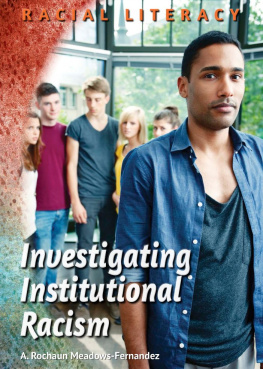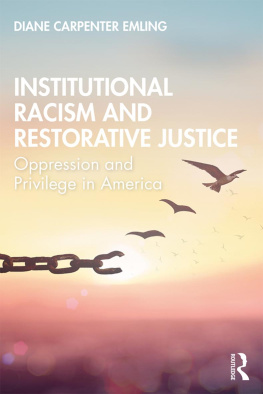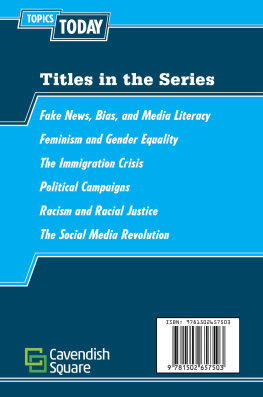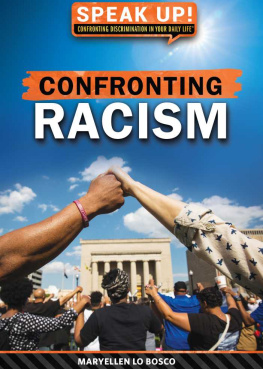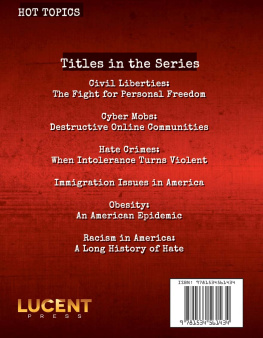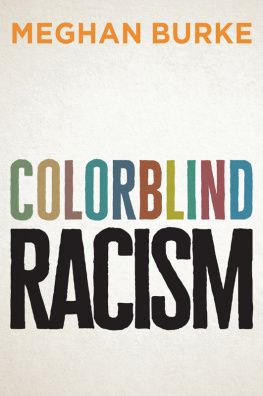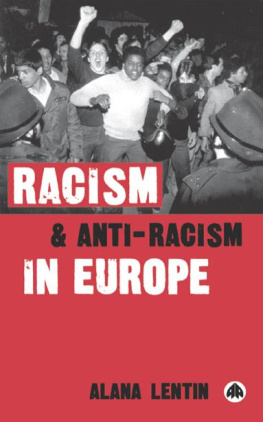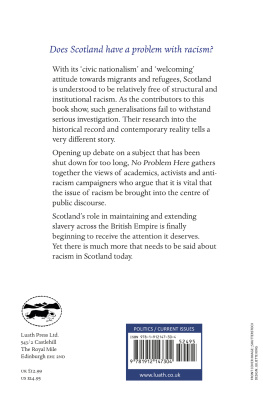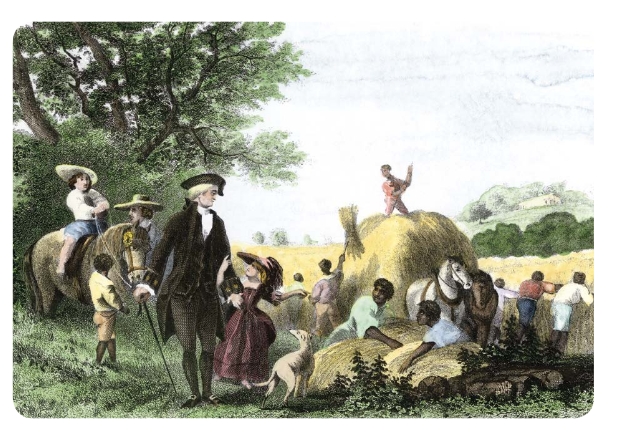Published in 2019 by Enslow Publishing, LLC.
101 W 23rd Street, Suite 240, New York, NY 10011
Copyright 2019 by Enslow Publishing, LLC.
All rights reserved.
No part of this book may be reproduced by any means without the written permission of the publisher.
Library of Congress Cataloging-in-Publication Data
Names: Meadows-Fernandez, A. Rochaun, author.
Title: Investigating institutional racism / A. Rochaun Meadows-Fernandez. Description: New York, NY : Enslow Publishing, 2019. | Series: Racial literacy | Audience: Grades 7-12. | Includes bibliographical references and index. Identifiers: LCCN 2018018854| ISBN 9781978504707 (Library bound) | ISBN 9781978505650 (pbk.) Subjects: LCSH: Racism-United States. | United States-Race relations. Classification: LCC E184.A1 M358 2019 | DDC 305.800973-dc23 LC record available at https://Lccn.Loc.gov/2018018854
Printed in the United States of America
To Our Readers: We have done our best to make sure all website addresses in this book were active and appropriate when we went to press. However, the author and the publisher have no control over and assume no liability for the material available on those websites or on any websites they may link to. Any comments or suggestions can be sent by e-mail to .
Photo Credits: Cover, p. 1 Bim/E+Getty Images; p. 5 North Wind Picture Archives; p. 6 Transcendental Graphics/Archive Photos/Getty Images; p. 9 adamkaz/Vetta/ Getty Images; pp. 11, 15, 21, 27, 36, 40 AP Images; p. 13 Ross Petukhov/ Shutterstock.com; p. 16 JuLie Dermansky/Corbis News/Getty Images; p. 17 Portland Press HeraLd/Getty Images; p. 18 BiLL PugLiano/Getty Images; p. 23 Baltimore Sun/ Tribune News Service/Getty Images; p. 28 David Portnoy/Getty Images; p. 30 Chester Brown/ALamy Stock Photo; p. 32 Viviane Moos/Corbis HistoricaL/Getty Images; p. 34 The Washington Post/Getty Images; p. 38 Photo 12/UniversaL Images Group/Getty Images; p. 42 GiLes CLarke/Getty Images; p. 46 ALeutie/ Shutterstock.com; p. 48 Witthaya Prasongsin/Moment/Getty Images; p. 50 Monkey Business Images/Shutterstock.com; p. 51 Onoky Photononstop/ALamy Stock Photo; pp. 53, 67 Andrey_Popov/Shutterstock.com; p. 54 Yeexin RicheLLe/ Shutterstock.com; p. 56 Boston GLobe/Getty Images; p. 57 HuLton Archive/Getty Images; p. 59 Darren Baker/Shutterstock.com; p. 61 Pacific Press/LightRocket/ Getty Images; p. 64 Win McNamee/Getty Images; p. 65 Andrew Lichtenstein/ Corbis News/Getty Images; p. 66 RawpixeL.com/Shutterstock.com; cover and interior pages background design Ensuper/Shutterstock.com (coLors), MiLoje/ Shutterstock.com (texture).
CONTENTS
Introduction
Before we can talk about racism, we must talk about race. Its confusing, messy, and more important, a social construct. Race is the idea that differences in the way we look, like skin color and hair texture, tell us about deeper differences like intelligence, behavioral patterns, and the likelihood of committing a crime.
In the United States, the use of racial hierarchies with white people at the top was created to justifythe land theft from and genocide of Native populations, along with the dehumanization of African slaves to justify slavery. Since then, Americans have been labeled white or other and treated accordingly. Americas systems were developed for the benefit of white Americans. Immediately after slavery, many Black Americans did work that closely resembled slave labor, as sharecroppers. Similarly, Jim Crow laws maintained Black Americans exclusion from the education system, employment industry, and access to the health care for many years afterward.
George Washington is shown walking through a field with his slaves in the surrounding area.
Racism is a math problem: Prejudice plus systemic power equals institutional racism. Systemic power is the ability to control systems like education, health care, media, and employment to the benefit of one group over others. While racism looks like different things to different people on an individual level, institutional racism is the bigger structural social framework that promotes racial discrimination. If individual racism is the school bully, then institutional racism is when the teacher hates you, too, and praises the bully while handing you unearned detention.
Institutional racism can also look like oversimplifying several distinct ethnic groups by reducing their variety of social and cultural traditions into one homogenous group. For example, in the United States there are 562 legally recognized Native tribes with individual languages, cultures, and customs. Unfortunately, social and cultural institutions often discuss them as one. There is a similar issue with Hispanic/Latinx people and Asians. The social construction of race forces oversimplifying race and ethnicity. Its not just black and white. Its important to note that you can be Asian and Latinx or Latinx and Native or Latinx and Black or any combination of the three. Whether you are white, Black, Native, Latinx, or Asian will have an effect on your life and access to opportunities.
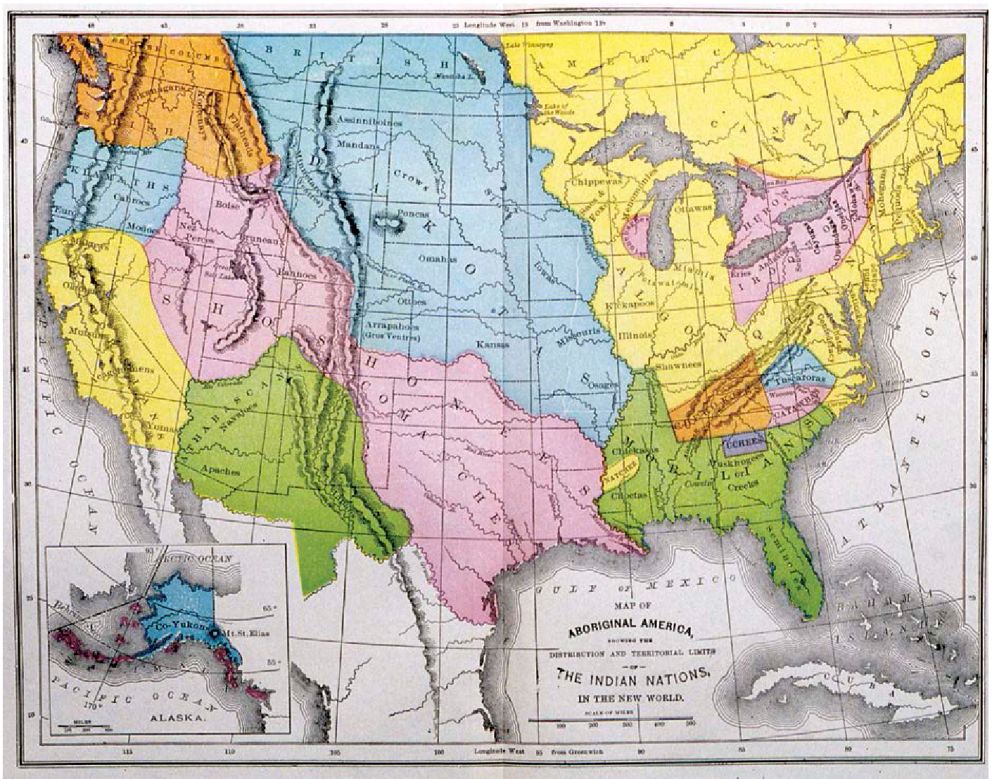
Our nation looked different two hundred years ago. Above is a map of Aboriginal America, showing some of the Native American tribes in 1870.
Institutional racism is all around us but is especially present in education, media, employment, the criminal justice system, and health care.
CHAPTER 1
What Is Institutional Racism?
Racism can show up in many ways. Sometimes it is easy to spot, like with stereotypes and bullying. But other times, racism is hidden in policies that target characteristics thought to help predict race, like income levels, names, and neighborhoods.
Individual Racism
Individual racism is the harmful things people say or do that are related to someone elses racial category. However, racism is much more complex than making mean comments and explicit exclusion. Another form of individual racism, also referred to as benevolent racism, is based on the idea that Black Americans and other minorities are incompetent and require white sympathy and assistance for success.

Bullying is a major problem in schools and should never be accepted.
Racism might Look Like a teacher or a student making a Black or Brown kid feel like their culture isnt OK to show in school. If a teacher teLLs an Arab American student that they cannot wear a hijab in their classroom because the teacher doesnt like it, its individual racism.
Institutional Racism
But institutional racism is when the systems in place, such as education, criminal justice, and health care, exclude or harm people of color. For example, a Black student was given a three-day suspension and a fine for standing up to a buLLy, but the white buLLy was given the chance to apoLogize and return to cLass-this is institutionaL racism.
Many individuals who carried personal prejudices and racist views wanted to do what they could to make sure things functioned like they did during the years after slavery-they wanted their neighborhoods and schools to stay white. The Civil Rights Act of 1964 helped to punish people for obvious acts of race-based discrimination in areas like employment and education.1 However, it could not stop less direct discrimination, like name screening for race, or change the prejudice that led people to discriminate in the first place.

